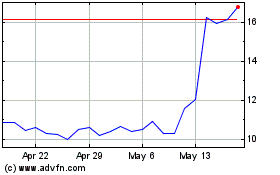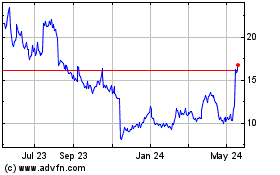Melt Pharmaceuticals Reports Positive Phase 3 Topline Efficacy Results for MELT-300, Its Lead Product Candidate for Opioid-Free, Sublingual Procedural Sedation in Patients Undergoing Cataract Surgery
20 November 2024 - 11:00PM
Business Wire
MELT-300 Demonstrates Statistically Superior
Compared to Both Sublingual Midazolam (P=0.009) and Placebo
(P<0.001) for Providing Successful Procedural Sedation
Proportion of Patients Requiring Rescue
Sedation Was Nearly Two-Fold Higher for Sublingual Midazolam
Compared with MELT-300 (P=0.003)
MELT-300 Had a Favorable Safety Profile That
Was Generally Comparable to Placebo
Melt Pharmaceuticals, Inc. (“Melt”), a clinical-stage
pharmaceutical company developing novel approaches for procedural
sedation, today announced positive topline results of its pivotal
Phase 3 study evaluating the safety and efficacy of its lead
product candidate, MELT‑300, a non-IV, non-opioid tablet for
procedural sedation during cataract surgery. Based on a Special
Protocol Assessment agreement reached with the U.S. Food and Drug
Administration (“FDA”) earlier this year, this study design and
these positive results support the necessary objectives required
for a regulatory submission.
MELT-300 uniquely combines a fixed dose of midazolam (3mg) and
ketamine (50mg) in one tablet that is administered sublingually
using Catalent’s proprietary Zydis® delivery technology which
dissolves in as little as 3 seconds allowing absorption of the
active ingredients across the sublingual mucosa.
The MELT-300 Phase 3 clinical trial was a randomized,
double-blind, three-arm study comparing, at a 4:1:1 ratio,
MELT-300, sublingual midazolam, and sublingual placebo,
respectively, for procedural sedation in patients undergoing
cataract surgery. The study was conducted at 13 clinical sites in
the United States and enrolled over 530 patients.
In commenting on the topline results, Dr. Larry Dillaha, Chief
Executive Officer of Melt, said, “We are extremely excited with
this robust topline data from our pivotal Phase 3 study. These
overwhelmingly positive results support our belief that MELT-300,
if approved by the FDA, would be a safe and effective non-IV,
non-opioid alternative to current IV-based cataract surgery
sedation protocols, which generally involve the administration of
opioids. With the number of cataract surgeries performed each year
in the U.S. expected to exceed 5 million in the coming years, we
believe offering patients and physicians the ability to achieve an
adequate sedation level without the need to start an IV or
administer opioids is a very attractive proposition.”
MELT-300 co-inventor, Melt Pharmaceuticals board member, and
board-certified ophthalmologist John Berdahl, M.D., commented, “A
proprietary compounded combination of midazolam and ketamine, which
was the inspiration for the development of the MELT-300 product
candidate, has been used by hundreds of ophthalmologists, including
myself – in hundreds of thousands of cataract surgeries. I am
thrilled at the prospect of the FDA approving MELT-300, which I
believe would greatly enhance the confidence of healthcare
professionals in considering the adoption of this groundbreaking
sedation method.”
George Magrath, M.D., a board-certified ophthalmologist and a
MELT-300 Phase 3 study principal investigator, commented, “These
Phase 3 data show the superiority of the combination of midazolam
and ketamine compared with midazolam alone. If approved, I believe
MELT-300 will be a safe and effective alternative to current
sedation methods used for cataract surgery. As an ophthalmologist,
I am excited about the prospect of using MELT-300 to enhance the
overall experience for my cataract surgery patients.”
Dr. Dillaha continued, “In addition to supporting a regulatory
submission, these MELT-300 Phase 3 data should further strengthen
our already strong patent portfolio, both domestically and
internationally. Further, with these data now confirming and
complementing our robust Phase 2 efficacy and safety results, we
believe we are well positioned to elevate the procedural sedation
standard of care for cataract surgery and, through lifecycle
management, eventually expand the potential use of MELT-300 to over
100 million annual procedures in various medical specialties,
including dermatology, plastic surgery, dentistry,
gastroenterology, and emergency care.
“Melt Pharmaceuticals is profoundly grateful to the Phase 3
MELT-300 study participants, whose involvement has been invaluable.
This includes the ophthalmologists, optometrists,
anesthesiologists, certified registered nurse anesthetists, staff,
and patients at the 13 U.S. clinical sites.”
About Melt Pharmaceuticals
Melt Pharmaceuticals, Inc. is a clinical-stage pharmaceutical
company focused on developing proprietary non-IV, non-opioid,
sedation, and analgesia therapeutics for human medical procedures
in the hospital, outpatient, and in-office settings. Melt intends
to seek regulatory approval through the FDA’s 505(b)(2) regulatory
pathway for its proprietary, patented small-molecule product
candidates, where possible. Melt’s core intellectual property is
the subject of multiple granted patents in North America, Europe,
Asia, and the Middle East. Melt Pharmaceuticals, Inc. is a former
subsidiary of Harrow, Inc. (Nasdaq: HROW) and was carved out as a
separately managed business in 2019. To learn more about Melt,
please visit their website, www.meltpharma.com.
Forward-Looking Statements
This press release contains forward-looking statements, which
are all statements other than those statements of historical facts.
No representation or warranty is made as to such statements, all of
which involve substantial risks and uncertainties. Actual results
could vary materially.
View source
version on businesswire.com: https://www.businesswire.com/news/home/20241120082898/en/
Investor Contact: Larry Dillaha, M.D. Chief Executive
Officer ldillaha@meltpharma.com
Media Contact: Deb Holliday Holliday Communications, Inc.
deb@hollidaycommunications.net 412-877-4519
Harrow (NASDAQ:HROW)
Historical Stock Chart
From Jan 2025 to Feb 2025

Harrow (NASDAQ:HROW)
Historical Stock Chart
From Feb 2024 to Feb 2025
